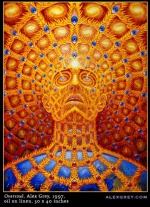Over-Soul
Over-Soul is a term used by Ralph Waldo Emerson in an essay first published in 1841, which is regarded as one of his best. For him, the Over-Soul is a supreme underlying unity which transcends plurality, much in the way non-dual philosophies describe reality. Helena Petrovna Blavatsky used this term as a synonym for anima mundi or ālaya, at a macrocosmic level, and for buddhi in human beings.
Emerson and the Over-Soul
Emerson's essay reflects the divine nature of the human soul, as connected to the collective conscious of the universe. He first reflects on the recognition of the Over-Soul within the self, and then further elaborates on its connection with other elements of the universal spirit. The essay has distinctive themes that reflect man's consciousness of the "Over-Soul":
- Existance of the Human Soul: Within the beginning paragraphs of The Over-Soul, Emerson remarks that beyond all actions of the personal life resides a deeper connection to the source of all action, as "Man is a stream whose source is hidden."[1] He attributes this source as the "Over-Soul", as "that Unity, that Over-soul, within which every man's particular being is contained and made one with all other; that common heart."[2]
- Nature of the Human Soul: The duality of the Self and the Soul is further highlighted by Emerson, as man is both the individual body and the collective "Over-Soul". He states that "We live in succession, in division, in parts, in particles. Meantime within man is the soul of the whole; the wise silence; the universal beauty, to which every part and particle is equally related; the eternal ONE."[3] When man acts from the soul, the truth of the higher self in man is displayed, as "When it breathes through his intellect, it is genius; when it breathes through his will, it is virtue; when it flows through his affection, it is love"[4]
- Relationship with the Personal Ego: Emerson contrasts the infinite being of the Over-Soul with the finite state of the personal ego. As the ego is bound by time, "The influence of the senses has, in most men, overpowered the mind to that degree, that the walls of time and space have come to look real and insurmountable...Yet time and space are but inverse measures of the force of the soul...Before the revelations of the soul, Time, Space, and Nature shrink away."
- Relationship with Other Human Souls:
- Relationship with the Soul of God:
He believed that through the Over-Soul every individual soul is “part or parcel of God.” Since we are part of God, we can find truth in without depending on external guidance. As he wrote in his essay:
It is because of the existence of this Over-Soul that all human beings share a common essence.
Over-Soul in Theosophy
Emerson's view was influenced by Eastern religions. There is evidence that he read The Bhagavad Gita and the Vedas. The essay also develops ideas present in the works of Plato, Plotinus, and Emanuel Swedenborg.
Mme. Blavatsky had Emerson's essay in high regard, referring to it as "his superb Essay on The Over-Soul".[5] She used this term in some of her writings, although in a somewhat different way. She agreed the Over-Soul was the common essence of all individual souls but did not regarded it as the highest principle in the cosmos (which is the Absolute or Universal Spirit, the seventh Principle, the root of everything). She wrote that the Third Fundamental Proposition of the The Secret Doctrine establishes:
The fundamental identity of all Souls with the Universal Over-Soul, the latter being itself an aspect of the Unknown Root.[6]
This, however, should not be interpreted as meaning the Over-Soul is different from the Universal Spirit. As Mme. Blavatsky wrote:
For us there is no over-soul or under-soul; but only ONE—substance: the last word being used in the sense Spinoza attached to it; calling it the ONE Existence, we cannot limit its significance and dwarf it to the qualification “over”; but we apply it to the universal, ubiquitous Presence, rejecting the word ‘Being,’ and replacing it with “All-Being.”[7]
The Over-Soul is regarded to be the sixth Principle in the cosmos, ālaya, the universal soul. It is a collective indivisible Soul of which all individual souls are rays or sparks. Its present in human beings is buddhi, which serves as the vehicle of atman:
As a general law, the Highest God, the Over-soul of the human being (Atma-Buddhi), only over-shadows the individual during his life, for purposes of instruction and revelation; or as Roman Catholics–who erroneously call that Over-soul the “Guardian Angel”–would say, “It stands outside and watches.”[8]
At the present stage of evolution the Over-Soul does not normally have an active presence in the personal consciousness. However, by means of Raja Yoga, the "human soul" or manas can be united to the Over-Soul, forming what is called "Buddhi-Manas".[9] The person then becomes a mystic and occultist.
Artistic representations

Alex Grey, an American artist specializing in "visionary art", painted an artwork in 1997 entitled Oversoul, in oil on linen. The dimensions are 30 x 40 inches.
Notes
- ↑ Source of Man at Emerson Central Online Text of The Over-Soul
- ↑ The Nature of the Over-Soul at Emerson Central Online Text of The Over-Soul
- ↑ Duality of Humanity at Emerson Central Online Text of The Over-Soul
- ↑ Living from the Soul at Emerson Central Online Text of The Over-Soul
- ↑ Helena Petrovna Blavatsky, Collected Writings vol. II (Wheaton, IL: Theosophical Publishing House, ???), 96.
- ↑ Helena Petrovna Blavatsky, The Secret Doctrine vol. I, (Wheaton, IL: Theosophical Publishing House, 1993), 17.
- ↑ Helena Petrovna Blavatsky, Collected Writings vol. X (Wheaton, IL: Theosophical Publishing House, 1989), 10, fn.
- ↑ Helena Petrovna Blavatsky, Collected Writings vol. XIV (Wheaton, IL: Theosophical Publishing House, 1988), 48.
- ↑ Helena Petrovna Blavatsky, The Theosophical Glossary (Krotona, CA: Theosophical Publishing House, 1973), 257.
Further reading
- The Over-Soul at American Transcendentalism Web